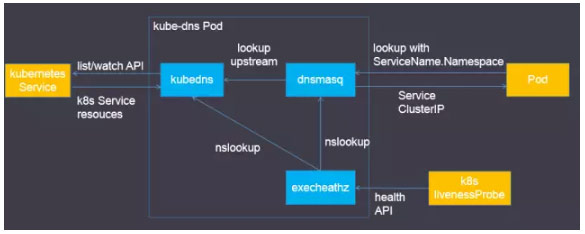k8s 1.4前的dns,有4个container组成, kube2sky, skyDNS, healthz, etcd。
-
kube2sky通过k8s API监视k8s service资源的变化,并根据service的信息生成 DNS 记录写入到etcd中。
-
skydns为集群中的 pod 提供 DNS 查询服务,DNS记录从etcd中读取。
-
exec healthz提供健康检查功能。
在 k8s 1.4版本后,dns进行重新梳理
- 监视k8s Service资源并更新DNS记录
- 替换etcd,使用TreeCache数据结构保存DNS记录并实现SkyDNS的Backend接口
- 接入SkyDNS,对dnsmasq提供DNS查询服务
- 对集群提供DNS查询服务
- 设置kubedns为upstream
- 提供DNS缓存,降低kubedns负载,提高性能
dnsmasq能够缓存外部DNS记录,同时提供本地DNS解析或者作为外部DNS的代理,即dnsmasq会首先查找/etc/hosts等本地解析文件,然后再查找/etc/resolv.conf等外部nameserver配置文件中定义的外部DNS。所以说dnsmasq是一个很不错的DNS中继。DNS配置同样写入dnsmasq.conf配置文件里。
- 定期检查kubedns和dnsmasq的健康状态
- 为k8s活性检测提供HTTP API
KubeDNS 启动参数:
/kube-dns--domain=cluster.local. --dns-port=10053 --config-map=kube-dns --v=0
创建 KubeDNS 对象,完成相关初始化工作
func NewKubeDNS(client clientset.Interface, clusterDomain string, timeout time.Duration, configSync config.Sync) *KubeDNS {
kd := &KubeDNS{
kubeClient: client,
domain: clusterDomain,
cache: treecache.NewTreeCache(), // 用于保存 dns 记录的 TreeCache 结构
cacheLock: sync.RWMutex{},
nodesStore: kcache.NewStore(kcache.MetaNamespaceKeyFunc), // 获取 k8s nodes 的接口
reverseRecordMap: make(map[string]*skymsg.Service),
clusterIPServiceMap: make(map[string]*v1.Service),
domainPath: util.ReverseArray(strings.Split(strings.TrimRight(clusterDomain, "."), ".")),
initialSyncTimeout: timeout,
configLock: sync.RWMutex{},
configSync: configSync,
}
kd.setEndpointsStore() // 获取 endpoints 信息的对象
kd.setServicesStore() // 获取 service 信息的对象
return kd
}获取 EndpointsStore 对象
func (kd *KubeDNS) setEndpointsStore() {
// Returns a cache.ListWatch that gets all changes to endpoints.
// 从 kcache.NewInformer 中返回 epStore 和 epsController
// kcache "k8s.io/client-go/tools/cache"
kd.endpointsStore, kd.endpointsController = kcache.NewInformer(
&kcache.ListWatch{
ListFunc: func(options v1.ListOptions) (runtime.Object, error) {
return kd.kubeClient.Core().Endpoints(v1.NamespaceAll).List(options)
},
WatchFunc: func(options v1.ListOptions) (watch.Interface, error) {
return kd.kubeClient.Core().Endpoints(v1.NamespaceAll).Watch(options)
},
},
&v1.Endpoints{},
resyncPeriod, // resyncPeriod = 5 * time.Minute
kcache.ResourceEventHandlerFuncs{
AddFunc: kd.handleEndpointAdd, // Add endpoint 的处理方式
UpdateFunc: kd.handleEndpointUpdate, // Update endpoint 的处理方式
// If Service is named headless need to remove the reverse dns entries.
DeleteFunc: kd.handleEndpointDelete, // delete enpoint 的处理方式
},
)
}
// 获取 ServicesStore 对象
func (kd *KubeDNS) setServicesStore() {
// Returns a cache.ListWatch that gets all changes to services.
kd.servicesStore, kd.serviceController = kcache.NewInformer(
&kcache.ListWatch{
ListFunc: func(options v1.ListOptions) (runtime.Object, error) {
return kd.kubeClient.Core().Services(v1.NamespaceAll).List(options)
},
WatchFunc: func(options v1.ListOptions) (watch.Interface, error) {
return kd.kubeClient.Core().Services(v1.NamespaceAll).Watch(options)
},
},
&v1.Service{},
resyncPeriod,
kcache.ResourceEventHandlerFuncs{
AddFunc: kd.newService,
DeleteFunc: kd.removeService,
UpdateFunc: kd.updateService,
},
)
}
NewInformer client-go 获取 相关对象
// NewInformer returns a Store and a controller for populating the store
// while also providing event notifications. You should only used the returned
// Store for Get/List operations; Add/Modify/Deletes will cause the event
// notifications to be faulty.
//
// Parameters:
// * lw is list and watch functions for the source of the resource you want to
// be informed of.
// * objType is an object of the type that you expect to receive.
// * resyncPeriod: if non-zero, will re-list this often (you will get OnUpdate
// calls, even if nothing changed). Otherwise, re-list will be delayed as
// long as possible (until the upstream source closes the watch or times out,
// or you stop the controller).
// * h is the object you want notifications sent to.
//
func NewInformer(
lw ListerWatcher,
objType runtime.Object,
resyncPeriod time.Duration,
h ResourceEventHandler,
) (Store, *Controller) {
func (kd *KubeDNS) newService(obj interface{}) {
if service, ok := assertIsService(obj); ok {
glog.V(2).Infof("New service: %v", service.Name)
glog.V(4).Infof("Service details: %v", service)
// ExternalName services are a special kind that return CNAME records
if service.Spec.Type == v1.ServiceTypeExternalName {
kd.newExternalNameService(service)
return
}
// if ClusterIP is not set, a DNS entry should not be created
if !v1.IsServiceIPSet(service) {
kd.newHeadlessService(service)
return
}
if len(service.Spec.Ports) == 0 {
glog.Warningf("Service with no ports, this should not have happened: %v",
service)
}
kd.newPortalService(service) // 最终会调用 kd.newPortalService
}
}func (kd *KubeDNS) newPortalService(service *v1.Service) {
subCache := treecache.NewTreeCache()
recordValue, recordLabel := util.GetSkyMsg(service.Spec.ClusterIP, 0)
subCache.SetEntry(recordLabel, recordValue, kd.fqdn(service, recordLabel))
// Generate SRV Records
for i := range service.Spec.Ports {
port := &service.Spec.Ports[i]
if port.Name != "" && port.Protocol != "" {
srvValue := kd.generateSRVRecordValue(service, int(port.Port))
l := []string{"_" + strings.ToLower(string(port.Protocol)), "_" + port.Name}
glog.V(2).Infof("Added SRV record %+v", srvValue)
subCache.SetEntry(recordLabel, srvValue, kd.fqdn(service, append(l, recordLabel)...), l...)
}
}
subCachePath := append(kd.domainPath, serviceSubdomain, service.Namespace)
host := getServiceFQDN(kd.domain, service)
reverseRecord, _ := util.GetSkyMsg(host, 0)
kd.cacheLock.Lock()
defer kd.cacheLock.Unlock()
kd.cache.SetSubCache(service.Name, subCache, subCachePath...)
kd.reverseRecordMap[service.Spec.ClusterIP] = reverseRecord
kd.clusterIPServiceMap[service.Spec.ClusterIP] = service
}
在 KubeDNS 的 Start 函数中启动接受时间的主体循环。
func (kd *KubeDNS) Start() {
glog.V(2).Infof("Starting endpointsController")
go kd.endpointsController.Run(wait.NeverStop)
glog.V(2).Infof("Starting serviceController")
go kd.serviceController.Run(wait.NeverStop)
kd.startConfigMapSync()
// Wait synchronously for the initial list operations to be
// complete of endpoints and services from APIServer.
kd.waitForResourceSyncedOrDie()
}


